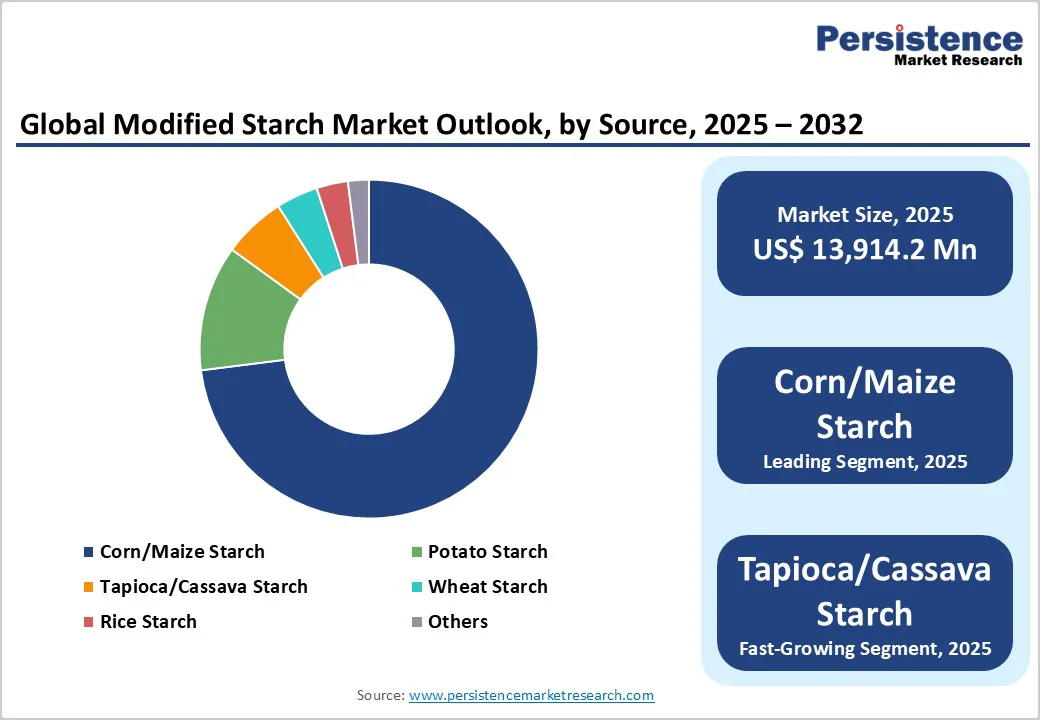ID: PMRREP29176| 189 Pages | 18 Nov 2025 | Format: PDF, Excel, PPT* | Food and Beverages

The global modified starch market size is likely to value US$ 13,914.2 million in 2025 and is projected to reach US$ 19,062.5 million at a CAGR of 4.6% during the forecast period from 2025 to 2032.
| Key Insights | Details |
|---|---|
|
Global Modified Starch Market Size (2025E) |
US$ 13,914.2 Mn |
|
Market Value Forecast (2032F) |
US$ 19,062.5 Mn |
|
Projected Growth (CAGR 2025 to 2032) |
3.4% |
|
Historical Market Growth (CAGR 2019 to 2024) |
4.6% |

Rising demand for texture, stability, and shelf-life enhancement in packaged foods is a key force propelling the global modified starch market. As consumers increasingly turn to ready-to-eat and processed food options, manufacturers rely on modified starches to improve viscosity, moisture retention, and freeze-thaw stability. These starches play a critical role in maintaining consistent product quality across sauces, bakery fillings, dairy desserts, and convenience meals. According to the USDA, U.S. processed food product exports reached a total value of $39.4 billion in 2024, underscoring the expanding global appetite for packaged food products. Modified starch enables longer shelf life and better sensory appeal, supporting both domestic production efficiency and international trade competitiveness amid growing consumer demand for reliable, high-quality packaged food experiences.
Fluctuating costs of corn, cassava, and potato crops pose a persistent challenge to producers in the global modified starch market, exerting direct pressure on profit margins. Since these crops form the core raw materials for starch extraction, any disruption in their supply chain whether due to climate variability, rising fertilizer costs, or trade restrictions, translates into higher input expenses. Price volatility in corn, driven by its competing demand for biofuel and feed applications, further amplifies cost instability. Similarly, cassava production is highly sensitive to weather patterns in tropical regions, while potato yields are affected by shifting agricultural cycles. These unpredictable fluctuations hinder pricing stability and long-term contract planning, forcing manufacturers to absorb cost shocks or pass them downstream, tightening competitiveness in the processed ingredient market.
Leveraging starch-based polymers to develop sustainable packaging alternatives is emerging as a pivotal opportunity for innovators in the global modified starch market. With increasing pressure to replace petroleum-based plastics, starch-derived biopolymers offer biodegradability, cost-effectiveness, and compatibility with existing manufacturing systems. Companies are investing in starch blends with polylactic acid (PLA) and polybutylene adipate terephthalate (PBAT) to produce flexible films, trays, and coatings suited for food and beverage packaging.
Startups are experimenting with water-resistant formulations and compostable laminates to enhance durability without compromising eco-performance. As governments tighten single-use plastic regulations and consumers demand low-carbon packaging, starch-based materials are positioned as a scalable, circular solution. This transition creates strong growth potential for starch processors integrating sustainable chemistry and biopolymer engineering into their product portfolios.
Corn/Maize Starch holds approx. 76% market share as of 2024, maintaining its dominance due to its versatility, availability, and functional efficiency across the food, textile, paper, and pharmaceutical industries. Derived from abundant corn crops, it serves as a key ingredient for thickening, stabilizing, and gelling applications in processed foods, beverages, and sauces. Its superior modification adaptability-such as cross-linked and pregelatinized forms enables performance consistency in varied processing conditions. Cassava starch, while valued for its clarity and neutral taste, remains regionally concentrated in tropical zones. Potato starch finds use in gluten-free formulations due to its viscosity and binding strength, though higher production costs limit scalability. The global reliance on corn-based starch reflects its economic advantage, widespread cultivation, and integration into evolving bio-based product innovations.
Tapioca/Cassava starch is projected to achieve a CAGR of 7.1% during the forecast period, driven by its expanding use as a clean-label, gluten-free, and plant-based ingredient in food and industrial applications. Extracted from cassava roots, it offers high clarity, neutral taste, and excellent thickening and binding properties, making it ideal for bakery, confectionery, and ready-to-eat meals. The surge in demand from Asia Pacific and Latin America, where cassava is a key agricultural crop, is fueling supply-side growth. In the textile, paper, and adhesive industries, tapioca starch is gaining attention as a biodegradable alternative to synthetic polymers. Increasing global focus on sustainable and allergen-free ingredients positions tapioca starch as a valuable solution for both food innovators and eco-conscious manufacturers.

North America holds approximately 36% market share in the global modified starch market, reflecting strong integration of starch derivatives across food, beverage, and industrial applications. In the United States, innovation in clean-label and plant-based formulations is driving the shift toward enzyme- and physically modified starches that deliver texture and stability without chemical additives. The growing processed food sector, supported by robust exports of U.S. food products, is reinforcing demand for functional starches in bakery, dairy, and ready-meal categories. In Canada, demand is rising for sustainable, bio-based materials, where starch-based polymers are being explored in packaging and biodegradable films. Regional manufacturers are prioritizing traceable sourcing, non-GMO labeling, and advanced modification technologies to meet evolving consumer and regulatory expectations for functionality, transparency, and sustainability.
Asia Pacific Modified Starch Market is expected to grow at a CAGR of 6.9% driven by the region’s expanding food, pharmaceutical, and textile sectors. In China, demand is surging for modified starch in ready-to-eat and instant food applications as consumer lifestyles shift toward convenience. India’s bakery and snack industries are incorporating modified starches to improve product stability under variable temperature and humidity conditions. Thailand, a leading tapioca starch exporter, is witnessing innovation in enzymatically and physically modified starches for clean-label and plant-based formulations. The growing use of modified starch in paper coating, adhesives, and biodegradable packaging materials further strengthens industrial applications across the Asia Pacific. Rapid investments in local starch processing capacities and advancements in cassava and corn starch modification technologies continue to shape the region’s evolving starch ecosystem.

The global modified starch market exhibits a moderately consolidated nature, with a mix of Multinational corporations and emerging regional processors competing on innovation and functionality. Leading players are expanding their portfolios with advanced enzymatic and physical modification technologies to improve performance in food and industrial uses. Companies are investing in sustainable farming partnerships to ensure non-GMO, traceable raw material supply chains, while vertically integrating processing units to reduce costs and improve quality control.
Startups are focusing on bio-based and clean-label starch derivatives for health-conscious consumers. Certification programs like USDA Organic and RSPO compliance are gaining popularity, reflecting increasing demand for ethical sourcing. Ongoing advancements in starch modification processes are transforming texture, stability, and environmental sustainability standards worldwide.
The global modified starch market is projected to be valued at US$13,914.2 Mn in 2025.
Rising demand for texture, stability, and shelf-life enhancement in packaged foods is driving the global modified starch market.
The global modified starch market is poised to witness a CAGR of 4.6% between 2025 and 2032.
Leveraging starch-based polymers to create sustainable packaging alternatives is the key market opportunity.
Major players in the global Modified Starch market include Cargill, Incorporated, Ingredion, ADM, Tate & Lyle, Roquette Frères, Tereos S.A., AGRANA Beteiligungs-AG, and others.
| Report Attribute | Details |
|---|---|
|
Historical Data/Actuals |
2019 - 2024 |
|
Forecast Period |
2025 - 2032 |
|
Market Analysis |
Value: US$ Mn |
|
Geographical Coverage |
|
|
Segmental Coverage |
|
|
Competitive Analysis |
|
|
Report Highlights |
|
By Product Type
By Form
By Application
By Region
Delivery Timelines
For more information on this report and its delivery timelines please get in touch with our sales team.
About Author